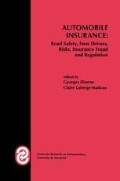Abstract
Fraud is recognized as a major problem in the insurance industry1 by practitioners and academics alike. To curb fraudulent behavior on the part of policyholders, not only have some insurers joined hands, but the government is also helping. The scientific literature (see Dionne, Gibbens and St-Michel, 1993; Weisberg and Derrig, 1991; and Hoyt, 1990 for further details) recognizes many types of insurance fraud, amongst which are build-up (exaggerating the loss amount) and planned fraud (reporting a loss when none occurred). Although, both of these types of fraud are important, for simplicity this paper concentrates only on planned fraud. Dionne, Gibbens and St-Michel (1993) report that at the minimum, fraudulent claims represent at least thirteen percent of all claims. This number does not seem exaggerated considering that one in five Americans believe it is okay to pad claims to make up for previously paid premiums or a policy’s deductible2.
This paper is a greatly modified version of a previous one titled Honesty Selection: Or Why an Honest Man may be Better off Surrounded by Criminals than by Fools. I would like to acknowledge the valuable inputs of Sharon Tennyson, Richard Butler, Steve Coate, Neil Doherty, Richard Derrig, Georges Dionne and Pierre Picard. The financial help of the S.S. Huebner Foundation and of the Social Science and Humanities Research Council of Canada is also greatly appreciated. Of course, all remaining errors are my own.
Access this chapter
Tax calculation will be finalised at checkout
Purchases are for personal use only
Preview
Unable to display preview. Download preview PDF.
References
Arnott, R.J. (1992), “Moral hazard and Competitive Insurance Markets”, in Contributions to Insurance Economics, G. Dionne ed. Kluwer Academic Publishers, Boston.
Becker, G.S.S. (1968), “Crime and Punishment: An Economic Approach”, Journal of Political Economy, 46:169–217.
Bond, E.W. and K.J. Crocker (1997), “Hardball and the Soft Touch: The Economics of Optimal Insurance Contracts with Costly State Verification and Endogenous Monitoring”, Journal of Public Economics, 63:239–254.
Boyer, M.M. (1998), Over-Compensation as a Partial Solution to Commitment and Renegotiation Problems: The Case of Ex-post Moral Hazard. Risk Management Chair, Working Paper 98-04, HEC-Montréal.
Cummins, J.D. and S. Tennyson (1992), “Controlling Automobile Insurance Costs”, Journal of Economic Perspectives, 6:95–115.
Cummins, J.D. and S. Tennyson (1996), “Moral Hazard in Insurance Claiming: Evidence from Automobile Insurance”, Journal of Risk and Uncertainty, 12:26–50.
Dionne, G., A. Gibbens and P. St-Michel (1993), An Economic Analysis of Insurance Fraud, Working paper #9310, Université de Montréal.
Dionne, G. and P. Viala (1992), Optimal Design of Financial Contracts and Moral Hazard, Working paper #9219, Université de Montréal.
Ehrlich, I. (1972), “Participation in Illegitimate Activities: A Theoretical and Empirical Investigation”, Journal of Political Economy, 80:521–565.
Gale, D. and M. Hellwig (1985), “Incentive-Compatible Debt Contracts: The One-Period Problem”, Review of Economic Studies, 52:647–664.
Gordon, J.P.F. (1990), “Individual Morality and Reputation Costs as Deterrents to Tax Evasion”, European Economic Review, 33:797–805.
Hoyt, R.E. (1989), “The Effect of Insurance Fraud on the Economic System”, Journal of Insurance Regulation, 8:304–315.
Mookherjee, D. and I. Png (1989), “Optimal Auditing, Insurance and Redistribution”, Quarterly Journal of Economics, 104:205–228.
Myerson, R.B. (1991), Game Theory. Harvard University Press, Cambridge, MA.
Picard, P. (1996), “Auditing Claims in the Insurance Market with Fraud: The Credibility Issue”, Journal of Public Economics, 63:27–56.
Reinganum, J.F. and L.L. Wilde (1985), “Income Tax Compliance in a Principal-Agent Framework”, Journal of Public Economics, 26:1–18.
Rothschild, M. and J.E. Stiglitz (1976), “Equilibrium in Competitive Insurance Markets: An Essay on the Economics of Imperfect Information”, Quarterly Journal of Economics, 90:629–649.
Townsend, R.M. (1979), “Optimal Contracts and Competitive Markets with Costly State Verification”, Journal of Economic Theory, 21:265–293.
Weisberg and Derrig (1991), “Fraud and Automobile Insurance: A Report on Bodily Injury Liability Claims in Massachusetts”, Journal of Insurance Regulation, 10:384–440.
Winter, R.A. (1992), “Moral Hazard and Insurance Contracts”, in Contributions to Insurance Economics, G.Dionne ed., Kluwer Academic Publishers, Boston.
Editor information
Editors and Affiliations
Rights and permissions
Copyright information
© 1999 Springer Science+Business Media New York
About this chapter
Cite this chapter
Boyer, M. (1999). When is The Proportion of Criminal Elements Irrelevant? A Study of Insurance Fraud When Insurers Cannot Commit. In: Dionne, G., Laberge-Nadeau, C. (eds) Automobile Insurance: Road Safety, New Drivers, Risks, Insurance Fraud and Regulation. Huebner International Series on Risk, Insurance, and Economic Security, vol 20. Springer, Boston, MA. https://doi.org/10.1007/978-1-4615-4058-8_8
Download citation
DOI: https://doi.org/10.1007/978-1-4615-4058-8_8
Publisher Name: Springer, Boston, MA
Print ISBN: 978-1-4613-6817-5
Online ISBN: 978-1-4615-4058-8
eBook Packages: Springer Book Archive

